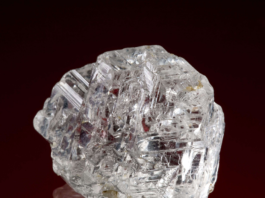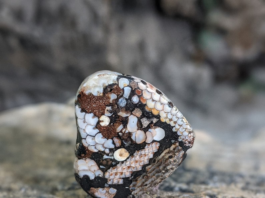Poppy Jasper is a unique and beautiful type of jasper, a variety of chalcedony, known for its distinctive red, brown, and sometimes yellow or orange colors, often resembling the petals of a poppy flower. It is primarily found in California, USA, particularly in the Santa Clara County and its surrounding regions. Poppy Jasper is highly regarded for its geological, historical, and cultural significance.

Geological Formation and Composition:
- Formation: Poppy Jasper is believed to have formed millions of years ago during the Cretaceous period. It is a sedimentary rock, and its distinct coloration is a result of various mineral impurities and other geological processes.
- Composition: Poppy Jasper is composed mainly of silica (quartz), which gives it its hardness and durability. The rich colors and patterns in Poppy Jasper are a result of the presence of iron, hematite, and other mineral inclusions. These minerals contribute to its unique red, brown, and sometimes yellow or orange hues.
- Patterns: Poppy Jasper is known for its eye-catching patterns, which often resemble landscapes, floral designs, or abstract shapes. These patterns are created by the intricate interplay of different mineral bands within the stone, making each piece of Poppy Jasper unique.
Historical and Cultural Significance:
- Local Gemstone: Poppy Jasper holds significant value in the Santa Clara County region, particularly in California’s history. It is considered the “official” state rock of California, a symbol of the state’s natural beauty and geological diversity.
- Lapidary and Jewelry: Poppy Jasper has been a favorite among lapidaries, artisans, and jewelry makers for its vibrant colors and unique patterns. It is often cut and polished to create beautiful cabochons, beads, and other decorative items.
- Healing Properties: In metaphysical and New Age circles, Poppy Jasper is believed to have various healing properties, including providing strength, vitality, and a connection to the Earth’s energy. Some people use it as a healing stone for emotional balance and grounding.
- Cultural Symbolism: Poppy Jasper’s colors and patterns have led to its association with natural themes, such as the poppy flower and the landscapes of California. It is sometimes used symbolically in art and crafts to represent the beauty and vitality of the region.
- Collector’s Item: Rare and unique variations of Poppy Jasper are sought after by collectors and enthusiasts. Some varieties are named after specific locations where they are found, such as Morgan Hill Poppy Jasper, which comes from the Morgan Hill area in California.
In summary, Poppy Jasper is a visually captivating and culturally significant gemstone with a rich geological history. Its unique patterns and colors, along with its association with California’s natural beauty, make it a valuable and cherished gemstone both in the world of geology and among those who appreciate its aesthetic and metaphysical qualities.
Contents
Physical and Chemical Properties of Poppy Jasper

Poppy Jasper, like other varieties of jasper, possesses certain physical and chemical properties that define its characteristics and make it distinct. Here are some of the key physical and chemical properties of Poppy Jasper:
Physical Properties:
- Color: The most notable characteristic of Poppy Jasper is its rich red, brown, and sometimes yellow or orange colors. These colors are often arranged in intricate patterns and bands, which can be quite captivating.
- Luster: Poppy Jasper typically has a dull to vitreous (glassy) luster when polished. The specific luster may vary depending on the quality of the polish.
- Transparency: It is usually opaque, meaning light does not pass through it. However, thin slices or slabs may exhibit some translucency.
- Hardness: On the Mohs scale of mineral hardness, Poppy Jasper has a hardness of approximately 6.5 to 7. This makes it relatively durable and suitable for use in jewelry and decorative items.
- Density: The density of Poppy Jasper can vary depending on its composition, but it typically falls within the range of 2.58 to 2.91 grams per cubic centimeter (g/cm³).
- Cleavage and Fracture: Poppy Jasper does not have cleavage, meaning it does not break along specific planes. Instead, it exhibits a conchoidal fracture, which produces smooth, curved surfaces when broken.
- Streak: The streak of Poppy Jasper is usually white to light brown, which can help distinguish it from other minerals.

Chemical Properties:
- Composition: Poppy Jasper is primarily composed of silica (SiO2), which is the most abundant mineral in the Earth’s crust. The distinctive colors and patterns in Poppy Jasper result from various mineral impurities and inclusions. Iron, hematite, and other minerals contribute to its coloring.
- Chemical Formula: The chemical formula of Poppy Jasper is essentially the same as that of quartz, SiO2, but with impurities that give it its unique colors.
- Mineral Class: Poppy Jasper belongs to the mineral class of chalcedony, which is a variety of microcrystalline quartz.
- Hardness: The hardness of Poppy Jasper is a result of its mineral composition. The presence of quartz in its structure gives it a relatively high hardness, making it suitable for various lapidary applications.
- Chemical Stability: Poppy Jasper is generally chemically stable and not easily affected by common acids. However, it may react with hydrofluoric acid due to its silica content.
- Specific Gravity: The specific gravity of Poppy Jasper varies based on its composition but typically falls in the range of 2.58 to 2.91.
These physical and chemical properties collectively contribute to the unique appearance, durability, and cultural significance of Poppy Jasper. Its striking colors and patterns, along with its geological history, make it a sought-after material for both artistic and decorative purposes.
Locations and regions where it is commonly found.

Poppy Jasper is primarily found in specific regions of California, USA, particularly in Santa Clara County and its surrounding areas. Here are some of the locations and regions where Poppy Jasper is commonly found:
- Morgan Hill, California: Morgan Hill, located in Santa Clara County, is one of the most famous and prolific sources of Poppy Jasper. The city is often associated with this variety of jasper, and it is sometimes referred to as “Morgan Hill Poppy Jasper.”
- Santa Clara County: Poppy Jasper is found in various areas within Santa Clara County, including Morgan Hill, along the Diablo Range, and in the foothills of the Santa Cruz Mountains. The county’s geological composition and history have contributed to the formation of this distinctive jasper.
- Central Coast of California: While Santa Clara County is the most well-known source, Poppy Jasper can also be found in some other parts of the central coast of California. These areas include parts of Monterey County and San Benito County.
- California’s Coastal Ranges: The geological conditions of California’s coastal ranges, including the presence of sedimentary rocks and minerals, have made it conducive for the formation of Poppy Jasper in various locations along the region.
- Gem and Mineral Shows: Poppy Jasper specimens are often showcased and sold at gem and mineral shows in California and other parts of the United States. These shows provide an opportunity for collectors and enthusiasts to acquire Poppy Jasper from various sources.
It’s important to note that while Poppy Jasper is primarily associated with California, it can also be found in other parts of the world, but these occurrences are less common. The distinctive patterns and colors of Poppy Jasper, along with its cultural significance in California, make it a highly sought-after gemstone among collectors, lapidaries, and jewelry enthusiasts.
Uses and Applications of Poppy Jasper

Poppy Jasper is a versatile and attractive gemstone with various uses and applications. Its unique colors, patterns, and properties make it a desirable material for a range of purposes. Here are some common uses and applications of Poppy Jasper:
- Jewelry: One of the most popular uses of Poppy Jasper is in jewelry design. It is often cut and polished into cabochons, beads, pendants, and other jewelry components. The distinctive colors and patterns make it an appealing choice for necklaces, earrings, bracelets, and rings.
- Lapidary Art: Poppy Jasper is a favorite among lapidaries and artisans who work with gemstones. It can be carved, sculpted, and shaped into various art pieces, including figurines, sculptures, and decorative items.
- Collectibles: Rare and unique varieties of Poppy Jasper are highly sought after by collectors. Some collectors specifically seek out Poppy Jasper specimens due to their aesthetic appeal and geological significance.
- Metaphysical and Spiritual Practices: Poppy Jasper is believed by some to have metaphysical properties, including grounding energy, providing strength, and promoting emotional balance. It is often used in crystal healing, meditation, and spiritual practices.
- Home Décor: Poppy Jasper’s vibrant colors and natural patterns make it suitable for use in home decor items. It can be incorporated into decorative tiles, coasters, and tabletops, adding a touch of natural beauty to interiors.
- Gift Items: Poppy Jasper jewelry and decorative items are often given as gifts due to their aesthetic appeal and potential metaphysical properties. They make thoughtful presents for various occasions.
- Landscape Design: In some cases, Poppy Jasper or similar stones are used in landscaping to create attractive and colorful pathways, garden borders, or rock gardens.
- Education and Geology: Poppy Jasper, as a representative of California’s geological history, is sometimes used in educational settings to teach students about geology and the Earth’s natural processes.
- Art and Crafts: Poppy Jasper’s unique patterns and colors can be used in various art and craft projects, such as mosaics, painting, and mixed-media creations.
- Local Symbolism: In regions where Poppy Jasper is abundant, it can be used as a symbol of local pride and natural beauty. It may be incorporated into regional logos, emblems, and public art installations.
Overall, Poppy Jasper’s uses and applications are diverse, ranging from jewelry and art to metaphysical practices and regional symbolism. Its striking appearance and cultural significance contribute to its popularity in various creative and practical endeavors.






